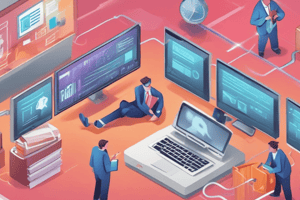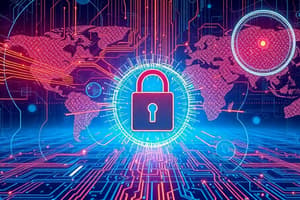Podcast
Questions and Answers
What is the primary purpose of an Information Security Management System (ISMS)?
What is the primary purpose of an Information Security Management System (ISMS)?
- To ensure compliance with financial regulations
- To increase employee productivity
- To enhance customer satisfaction
- To protect and manage an organization's information (correct)
Which of the following is NOT a benefit of ISO 27001?
Which of the following is NOT a benefit of ISO 27001?
- Secure information in all forms
- Ensure complete protection against all cyber attacks (correct)
- Adapt to evolving security threats
- Reduce costs associated with information security
How many controls are there in ISO 27001?
How many controls are there in ISO 27001?
- 75
- 135
- 47
- 114 (correct)
Which of the following is a component of the NIST Cybersecurity Framework (CSF)?
Which of the following is a component of the NIST Cybersecurity Framework (CSF)?
Which area does NOT fall under the ISO 27001 controls?
Which area does NOT fall under the ISO 27001 controls?
What does an ISMS help organizations adapt to?
What does an ISMS help organizations adapt to?
Which of the following describes the Core component of the NIST CSF?
Which of the following describes the Core component of the NIST CSF?
How does ISO 27001 help with the security of information?
How does ISO 27001 help with the security of information?
What are the potential consequences of a cyber attack on critical infrastructure?
What are the potential consequences of a cyber attack on critical infrastructure?
What characteristic of cyber warfare makes it challenging to assign blame?
What characteristic of cyber warfare makes it challenging to assign blame?
How does the speed of cyber warfare compare to traditional warfare?
How does the speed of cyber warfare compare to traditional warfare?
What will future warfare likely incorporate?
What will future warfare likely incorporate?
Which aspect of cyber warfare complicates legal considerations?
Which aspect of cyber warfare complicates legal considerations?
What is a key feature of attackers in cyber warfare?
What is a key feature of attackers in cyber warfare?
What does the term 'multi-domain warfare' refer to?
What does the term 'multi-domain warfare' refer to?
Which of the following is NOT an example of critical infrastructure likely targeted by cyber attacks?
Which of the following is NOT an example of critical infrastructure likely targeted by cyber attacks?
What is the main purpose of IT security governance?
What is the main purpose of IT security governance?
Who is responsible for ensuring compliance with policies and determining information classification?
Who is responsible for ensuring compliance with policies and determining information classification?
Which role primarily ensures that data meets regulatory requirements and business needs?
Which role primarily ensures that data meets regulatory requirements and business needs?
What is a key responsibility of a Data Custodian?
What is a key responsibility of a Data Custodian?
What role does a Data Protection Officer hold within an organization?
What role does a Data Protection Officer hold within an organization?
Which of the following statements best describes a cybersecurity policy?
Which of the following statements best describes a cybersecurity policy?
What is the role of a Data Processor in an organization?
What is the role of a Data Processor in an organization?
What does effective IT security governance help align with an organization's objectives?
What does effective IT security governance help align with an organization's objectives?
What is the primary focus of the CIS Critical Security Controls framework?
What is the primary focus of the CIS Critical Security Controls framework?
Which of the following outlines the steps in the NIST Risk Management Framework?
Which of the following outlines the steps in the NIST Risk Management Framework?
What are the three major areas of the NIST Cybersecurity Framework?
What are the three major areas of the NIST Cybersecurity Framework?
Which ISO standard is specifically related to information security management systems?
Which ISO standard is specifically related to information security management systems?
What distinguishes a type 1 audit from a type 2 audit in SSAE 18 / SOC 2?
What distinguishes a type 1 audit from a type 2 audit in SSAE 18 / SOC 2?
What is the role of the Cloud Controls Matrix (CCM)?
What is the role of the Cloud Controls Matrix (CCM)?
Which of the following statements about ISO IEC 27701 is true?
Which of the following statements about ISO IEC 27701 is true?
Which organization developed the Cloud Controls Matrix (CCM)?
Which organization developed the Cloud Controls Matrix (CCM)?
What is the primary focus of the GOVERN function in cybersecurity?
What is the primary focus of the GOVERN function in cybersecurity?
Which of the following is included in the IDENTIFY function?
Which of the following is included in the IDENTIFY function?
How does the GOVERN function contribute to enterprise risk management?
How does the GOVERN function contribute to enterprise risk management?
What role does the IDENTIFY function play in relation to organizational policies?
What role does the IDENTIFY function play in relation to organizational policies?
In the context of the PROTECT function, which statement is accurate?
In the context of the PROTECT function, which statement is accurate?
What is an outcome of the GOVERN function?
What is an outcome of the GOVERN function?
Which aspect is NOT associated with the IDENTIFY function?
Which aspect is NOT associated with the IDENTIFY function?
What does the GOVERN function establish within an organization?
What does the GOVERN function establish within an organization?
Flashcards
IT Security Governance
IT Security Governance
The decision-making framework for managing cybersecurity risks within an organization, ensuring accountability and alignment with business objectives.
Data Governance
Data Governance
The process of managing and controlling the use of data within an organization, ensuring compliance with policies and regulations.
Data Owner
Data Owner
The person responsible for classifying information assets, setting access criteria, and ensuring compliance with policies.
Data Controller
Data Controller
Signup and view all the flashcards
Data Processor
Data Processor
Signup and view all the flashcards
Data Custodian
Data Custodian
Signup and view all the flashcards
Data Steward
Data Steward
Signup and view all the flashcards
Data Protection Officer (DPO)
Data Protection Officer (DPO)
Signup and view all the flashcards
Cybersecurity Policy
Cybersecurity Policy
Signup and view all the flashcards
CIS Critical Security Controls
CIS Critical Security Controls
Signup and view all the flashcards
NIST Risk Management Framework (RMF)
NIST Risk Management Framework (RMF)
Signup and view all the flashcards
NIST Cybersecurity Framework (CSF)
NIST Cybersecurity Framework (CSF)
Signup and view all the flashcards
ISO/IEC Frameworks
ISO/IEC Frameworks
Signup and view all the flashcards
SSAE 18 / SOC 2
SSAE 18 / SOC 2
Signup and view all the flashcards
Cloud Controls Matrix
Cloud Controls Matrix
Signup and view all the flashcards
ISO 27001
ISO 27001
Signup and view all the flashcards
Information Security Management System (ISMS)
Information Security Management System (ISMS)
Signup and view all the flashcards
Benefits of ISO 27001
Benefits of ISO 27001
Signup and view all the flashcards
ISO 27001 Controls
ISO 27001 Controls
Signup and view all the flashcards
NIST Cybersecurity Framework 2.0 (CSF)
NIST Cybersecurity Framework 2.0 (CSF)
Signup and view all the flashcards
Govern (CSF Core Component)
Govern (CSF Core Component)
Signup and view all the flashcards
Identify (CSF Core Component)
Identify (CSF Core Component)
Signup and view all the flashcards
Protect (CSF Core Component)
Protect (CSF Core Component)
Signup and view all the flashcards
Cyber Warfare Trends
Cyber Warfare Trends
Signup and view all the flashcards
Gray Zone Operations
Gray Zone Operations
Signup and view all the flashcards
Cyber, Kinetic, and Information Warfare
Cyber, Kinetic, and Information Warfare
Signup and view all the flashcards
Study Notes
Governance
- IT security governance dictates decision-making authority regarding cybersecurity risks within organizations.
- Ensures accountability and oversight in mitigating risks and aligning security strategies with business objectives and regulations.
- Data governance is critical for managing decisions about data within organizations.
Key Roles in Data Governance
- Data Owner: Ensures compliance with policies, classifies information assets, and sets access criteria.
- Data Controller: Determines purposes and methods for processing personal data.
- Data Processor: Processes personal data on behalf of the data controller.
- Data Custodian: Implements classification and security controls according to data owner rules.
- Data Steward: Ensures that data satisfies business needs and regulatory requirements.
- Data Protection Officer: Oversees the organization’s data protection strategy.
Cybersecurity Policies
- High-level documents outline an organization's vision, including goals, scope, and responsibilities for cybersecurity.
- Emphasize commitment to security and compliance with frameworks like:
- CIS Critical Security Controls: Focuses on 20 essential security controls based on organization size.
- NIST Risk Management Framework: Required for US federal agencies with six lifecycle steps: categorize, select, implement, assess, authorize, and monitor.
- NIST Cybersecurity Framework: Designed for commercial use, incorporating core functions, implementation tiers, and profiles.
- ISO/IEC Frameworks: Includes ISO 27001, 27002, 27701, and 31000 addressing various security and risk management standards.
- SSAE 18 / SOC 2: Auditing standards with type 1 (single point in time) and type 2 (periodic evaluation) audits.
- Cloud Controls Matrix: Aligns cloud security controls to standards and regulations.
ISO 27001 Overview
- Specifies requirements for an Information Security Management System (ISMS).
- ISMS protects and manages all forms of information and ensures compliance with information security regulations.
Benefits of ISO 27001
- Secures diverse information formats (digital, paper, cloud).
- Enhances resilience against cyberattacks and evolving threats.
- Minimizes risks from staff negligence and inadequate procedures.
- Ingrains security into daily business practices.
ISO 27001 Controls
- Comprises 114 controls across various security dimensions, including:
- Physical access control and firewall policies.
- Security staff awareness programs and threat monitoring procedures.
- Incident management processes and data encryption.
NIST Cybersecurity Framework 2.0 (CSF)
- Aids organizations in managing cybersecurity risks and resilience.
- Core Components include:
- Govern: Establishes risk management strategy and cybersecurity expectations.
- Identify: Understands organizational assets and related cybersecurity risks.
- Protect: Implements safeguards to manage identified risks.
Cyber Warfare Trends
- Targets critical infrastructure leading to widespread chaos.
- Operates in a gray zone complicating attribution and legal accountability.
- Advances at speeds faster than conventional warfare, with evolving attack methodologies.
- Future conflicts expected to merge cyber, kinetic, and information warfare tactics.
Studying That Suits You
Use AI to generate personalized quizzes and flashcards to suit your learning preferences.




